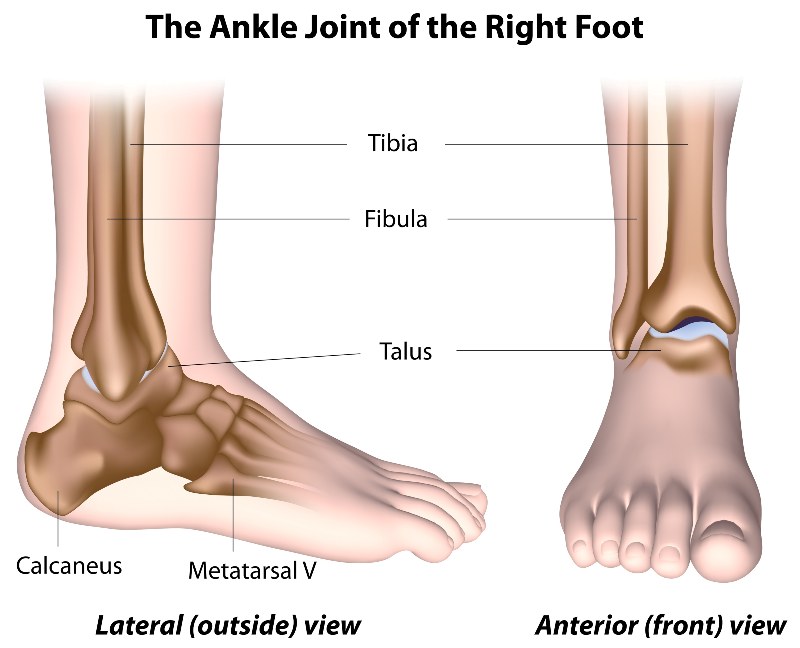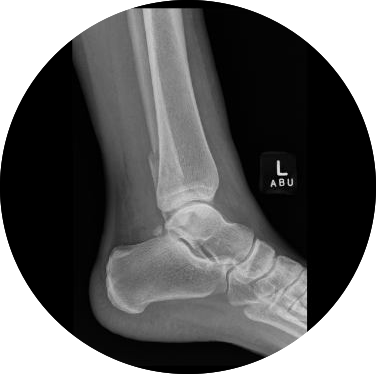ANKLE FRACTURE SURGERY MELBOURNE
ANKLE FRACTURE
What is an ankle fracture?
A broken ankle is also known as an ankle “fracture.”
This means that one or more of the bones that make up your ankle joint are broken – See figure 1 -Ankle joint anatomy below.
ANKLE ANATOMY
What are the bones in your ankle?
The ankle joint allows up and down movement of your foot. There is also another joint below the ankle joint called the subtalar joint that allows side to side motion of your foot.
The ankle joint is made up of three bones:
1. Tibia – Your shin bone.
2. Fibula – The thinner bone on the outside of your shin bone.
3. Talus – This sits in between the ankle and your heel bone (calcaneum).
Your ankle joint is also stabilised by ligaments and other soft tissues, which are also often injured as a result of an ankle fracture.

Figure 1
TYPES OF ANKLE FRACTURES
Most common ankle fractures
Common ankle fractures include:
Fibula fracture – Known as lateral malleolus.
Bimalleolar ankle fracture – Both sides “bi” are broken – fibula and tibia.
Trimalleolar ankle fracture – Breaks occur on three “tri” sides of your ankle:
- The outside fibula ” lateral malleolus”
- The inside tibia, “medial malleolus” and;
- The back of the tibia” posterior malleolus”.
Pilon fracture – A fracture that goes through the middle of your ankle joint.
Trimalleolar and pilon fractures have a much higher risk of cartilage and soft tissue injury that surround the ankle.
ANKLE FRACTURE ASSESSMENT
Assessing your ankle injury
To help with the accurate diagnosis of your ankle injury:
- A physical exam and history – It is important to identify how the injury occurred, as well as investigating the anatomical site of the injury.
- X-ray – helps to confirm the type of fracture and if it can be treated without surgery.
Special scans are sometimes needed
These include:
- CT scan – Provides a 3D image of the bone injury with very fine detail.
- MRI scan – Is a 3D image of the soft tissue injury including cartilage.
DO YOU NEED ANKLE SURGERY?
There are a range of options Mr Keith will discuss before opting for surgery.
Ankle fractures can be successfully treated without surgery using:
- Braces
- Casts, and/or
- Cam boots.
Mr Keith will discuss the options available to your specific situation

POTENTIAL COMPLICATIONS
Complications which may occur after your fracture and or operation may include:
- Ankle stiffness
- Ankle swelling commonly up to 6 months
- Ankle stiffness with restricted movement
- Infection and or wound related
- Numbness or tingling over your foot
- Fracture non union (not healing) or malunion (healed in a malunited position)
- DVT (deep vein thrombosis) or PE (pulmonary embolus)
- Further surgery to remove prominent metalware
Mr Keith will discuss with you in detail the potential risks and complications in relation to your ankle condition.
ANKLE SURGERY MELBOURNE
Helpful information and frequently asked questions (FAQ’s)
Ankle Surgery Melbourne
Mr Keith consults to patients from all over Melbourne in relation to ankle fractures and surgery. Mr Keith consults with patients at the following practice locations in Melbourne Armadale, Malvern, Richmond, Heidelberg and in Shepparton, country Victoria.


